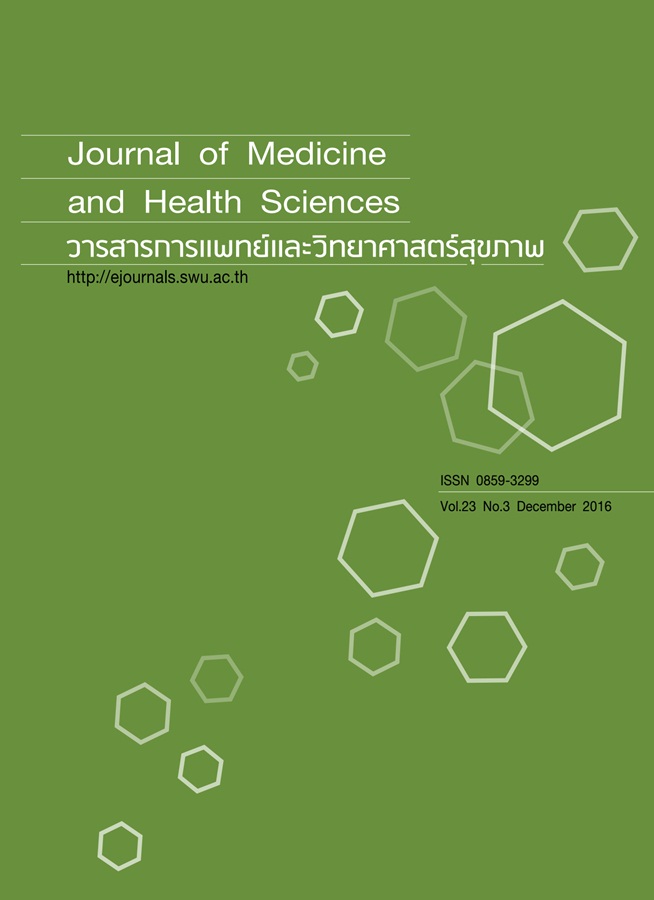Factors affecting postpartum hysterectomy: study in Chonprathan Hospital ปัจจัยที่มีผลต่อการผ่าตัดมดลูกฉุกเฉินหลังคลอดในโรงพยาบาลชลประทาน
Keywords:
peripartum hysterectomy, Incidence, risk factors การผ่าตัดมดลูกฉุกเฉินหลังคลอด ปัจจัยเสี่ยง อุบัติการณ์Abstract
Abstract
The aim of this study was to evaluate the prevalence and risk factors of emergency peripartum hysterectomy. A case-control study was conducted in the pregnant women who delivered at Chonprathan Hospital during January 2007 - December 2012. The study cases refered to pregnant women with gestational age more than 28 weeks who underwent emergency peripartum hysterectomy following cesarean or vaginal delivery. The control cases refered to pregnant women who delivered before and after the study cases were ratio 1:4.The medical records were collected and data were analyzed. Multivariate logistic regression analysis was used to identify independent risk factors with95% confidence intervals (95% CI). During the study period, there were 26 cases of emergency peripartum hysterectomy (1.88:1,000 deliveries). In the completed data 26 cases, the main indications for surgery were postpartum hemorrhage with uterine atony (50.0%), placental factors (27.0%), and hematoma of lower uterine segment and broad ligament (23.0%). According to multivariate analysis, independent risk factors were age of the pregnant woman more than 35 years (aOR=8.1, 95%CI=1.2 - 53.6), gravidity more than 2 (aOR=3.1, 95%CI=1.1-16.9), gestational age more than 40 weeks (aOR=12.5, 95%CI=1.1-194.6), caesarean section (aOR=87.1, 95%CI=10.5-724.4) and postpartum hemorrhage (aOR=75.1, 95%CI=41.3-189.2). The prevalence of emergency peripartum hysterectomy was increasing. Women at highest risk of emergency hysterectomy are those who are more than 35 years of age, multiparous, had a caesarean delivery, or abnormal placentation, uterine atony due to postpartum hemorrhage. The medical team should assess risks from long-term prenatal care, childbirth and the postpartum period, the sensitivity and precision in predicting the amount of blood loss after 24 hours, as well as raising awareness and understanding of patients and their families adequately about the risks, prevention and treatment.
บทคัดย่อ
การศึกษาครั้งนี้มีวัตถุประสงค์เพื่อศึกษาอุบัติการณ์ และปัจจัยที่เกี่ยวข้องกับการผ่าตัดมดลูกฉุกเฉินหลังคลอดของหญิงตั้งครรภ์ที่มีอายุครรภ์ 28 สัปดาห์ขึ้นไป ที่มาคลอดและได้รับการผ่าตัดมดลูกฉุกเฉินในระยะหลังคลอด ระหว่าง วันที่ 1 มกราคม 2551 ถึง 31 ธันวาคม 2556 เป็นการศึกษาเปรียบเทียบปัจจัยเสี่ยงระหว่างกลุ่มศึกษาและกลุ่มควบคุม โดยทบทวนเวชระเบียนของโรงพยาบาล ทะเบียนแผนกผ่าตัด และทะเบียนแผนกหลังคลอด รวบรวมข้อมูลที่อาจเป็นปัจจัยเสี่ยงในระยะต่าง ๆ ได้แก่ การตั้งครรภ์ การคลอด หลังคลอด การผ่าตัดมดลูก และภาวะแทรกซ้อนหลังผ่าตัดมดลูก วิเคราะห์ข้อมูลด้วยสถิติเชิงพรรณนา ได้แก่ ความถี่ ร้อยละ ค่าเฉลี่ย และความสัมพันธ์โดยใช้สถิติ Chi-square, odd ratio, 95% Confidence interval และ Multiple logistic regression ผลการศึกษา ในระยะเวลา 6 ปี ที่โรงพยาบาลชลประทาน มีจำนวนหญิงตั้งครรภ์คลอด 13,845 ราย จำนวนหญิงตั้งครรภ์ที่ได้รับการผ่าตัดมดลูกฉุกเฉินหลังคลอด 26 ราย คิดเป็นอุบัติการณ์ 1.88 : 1,000 การคลอด โดยข้อบ่งชี้ในการผ่าตัดมดลูกฉุกเฉินหลังคลอด โดยทั้งหมดมีภาวะตกเลือดหลังคลอดร่วมกับ uterine atony (50.0%), placental factors (27.0%) และ hematoma of lower uterine segment and broad ligament (23.0%) สำหรับปัจจัยเสี่ยงที่มีนัยสำคัญทางสถิติ โดยเรียงจากมากไปน้อย ได้แก่ การสูญเสียเลือดหลังคลอดมากกว่า 1,000 มล. (aOR=75.1, 95%CI=41.3-189.2), การผ่าตัดคลอดทางหน้าท้อง (aOR=87.1, 95%CI=10.5-724.4), อายุครรภ์มากกว่า 39 สัปดาห์ (aOR=12.5, 95%CI=1.1-194.6), มารดาอายุมากกว่า 35 ปี (aOR=8.1, 95%CI=1.2 - 53.6) และจำนวนการตั้งครรภ์มากกว่า 2 ครั้ง (aOR=3.1, 95%CI=1.1-16.9) โดยสรุป แนวโน้มการผ่าตัดมดลูกฉุกเฉินหลังคลอดเพิ่มขึ้น ในมารดากลุ่มเสี่ยงที่มีอายุมากกว่า 35 ปี ตั้งครรภ์มากกว่า 2 ครั้ง การผ่าตัดคลอดทางหน้า และมีการสูญเสียเลือดหลังคลอดจากความผิดปกติของมดลูกหรือรก บุคลากรในโรงพยาบาลควรประเมินปัจจัยเสี่ยงตั้งแต่ระยะฝากครรภ์ ระยะคลอด และระยะหลังคลอด รวมทั้งมีความไวและความแม่นยำในการคาดคะเนปริมาณการเสียเลือดหลังคลอด 24 ชั่วโมง ตลอดจนการสร้างความตระหนักและความรู้ความเข้าใจกับผู้ป่วยและญาติอย่างเพียงพอเกี่ยวกับความเสี่ยง การป้องกัน และการรักษา



